How To Get Rid of Dog Mites – Expert Treatments & Prevention
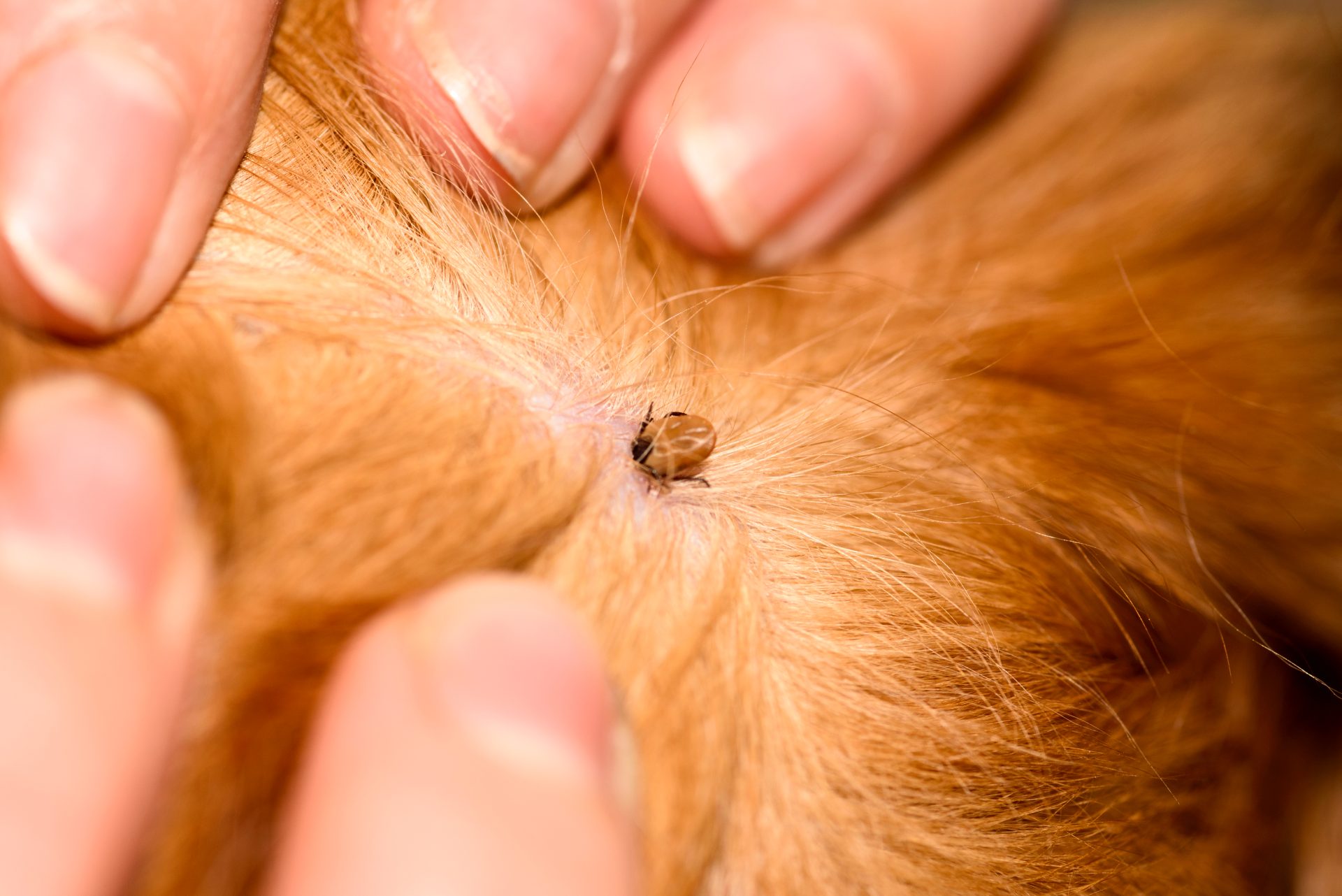
Have you recently run into the unfortunate problem of pesky mites with your dog? These tiny little creatures are extremely bothersome for your pooch, burrowing deep into their skin, causing all sorts of irritation and skin issues.
Getting mites can be more common than you might think. Mites are extremely contagious, transferring to other dogs in a flash.
Cases of mite infestations might even be more common in your area, they’re often passed around by foxes, stray dogs or just dogs that enjoy a lot of outdoors freedom.
One thing is for sure, having mites is a very unpleasant experience for your dog and one that you should look to resolve straight away.
What are dog mites?
Mites are very small creatures which are about a millimetre long. Disturbingly, they burrow into your dog’s skin and cause a lot of inflammation. They’re commonly thought of as parasites which can cause hair loss, dry skin and sores.
Mites typically live in your dog’s fur or ears. They cause a skin condition often referred to as “mange”, although it is sometimes referred to as Acariasis or canine scabies.
However, did you know there are three different types of common mites known to cause health issues in dogs?
1
Demodex Mites
These mites live on nearly all dogs without causing problems. However, in some dogs with immune issues, Demodex Mites can multiply and cause painful skin disease, at this stage it is referred to as “demodectic mange”.
2
Sarcoptic Mites
These mites are what cause mange, more specifically “sarcoptic mange”. Sarcoptic Mange is highly contagious between dogs and foxes but can in rare cases pass onto humans.
3
Ear Mites A.k.a – Otodectes Cynotis Mites
Ear mites make themselves at home in your dog’s ear canals, where they like the warm and moist environment. They cause intensely itching ears which can lead to worsening infections. Ear mites can also pass onto other household pets, such as cats.
How do dogs get mites?
Dogs usually get mites from other dogs as the eggs are easily and quickly transferred. However, dogs can also pick up mites from their surrounding environment too.
Common places for dogs to pick up mites are typically within dog shelters, pet grooming salons and doggy day care or group training sessions. Typically dogs will be checked first, but this isn’t foolproof and mistakes happen. Additionally, your dog may be unfortunate enough to pick them up from playing with other dogs whilst out on your daily walk.
It’s also important to keep their environment clean. Mites can go on to live in their bedding, the carpet and furniture around the house. So once you’ve established an issue with mites, it’s on you to ensure that your house is deep cleaned to rid the infection.
Lastly, a common transference of mites is the fox (both urban and countryside). This may be difficult to fully control, but owners should do what they can to not encourage foxes into the backyard and to warn your dog away from them if they ever appear to interact.
How do I know if my dog has mites?
Sarcoptic mange is extremely itchy for your dog and causes very unpleasant skin conditions. A dog with a Sarcoptic mange infestation will likely damage their own coat and skin with constant scratching which will lead to sores and scabs.
Sarcoptic mange typically affects the skin around the eyes and feet first, but will likely spread to other parts of the body.
Demodectic mange typically affects younger dogs with impaired immune systems. It’s a serious skin complaint that causes hair loss, scaling of the skin, redness, crusting and legions. It must be treated instantly.
Ear mites can affect dogs of all ages, typically symptoms will include extreme irritation and scratching of the ears from your dog, along with a restlessness and inability to settle. This can then be a precursor to more serious ear infections which will require veterinary treatment.
In some cases, owners may actually be able to see mites on their dogs skin under a close inspection. They are roughly a millimetre in length, so very small. However, parting the fur around the body may show visible spots.
Attentive owners should also be able to pick up on obvious behavioural cues from the dog such as a restlessness, excessive scratching, chewing themselves, not sleeping, whining and in some cases coming off their food.
If you suspect mites, then it’s best to not take any risks and contact your local vet for appropriate treatment. A qualified vet will be able to diagnose the issue, alongside what type of mite it is by analysing your dogs skin under a microscope.
dog Mite Pictures – What do Dog Mites Look like?
Mites are mostly microscopic and reach about 1mm in length. However, it is possible to get a close up on them when parting the fur, or by getting a glance under the microscope.
Each of the different types of mite (Demodex, Sarcoptic, Otodectes Cynotis) vary in appearance, but look similar to the naked eye. Typically you’ll see a head buried into your dogs epidermis. Below are some pictures of dog mites and what to look for on your dog.
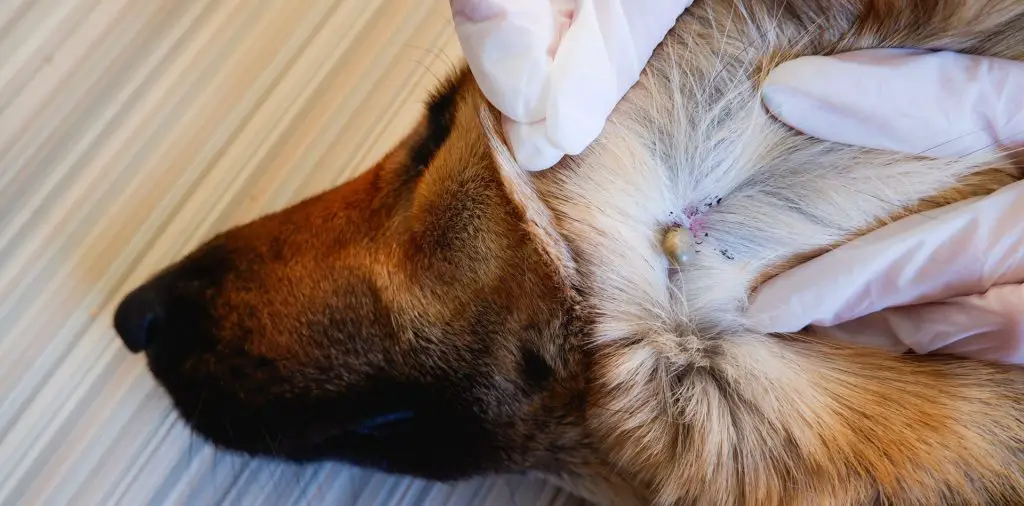
This picture of dog mites shows the parting of fur near the German Shepherds head, it reveals an infestation of small mites and redness in the skin.

This dog mite picture reveals how a mite appears close up, with its head buried into the dogs skin, likely causing a lot of irritation and pain.
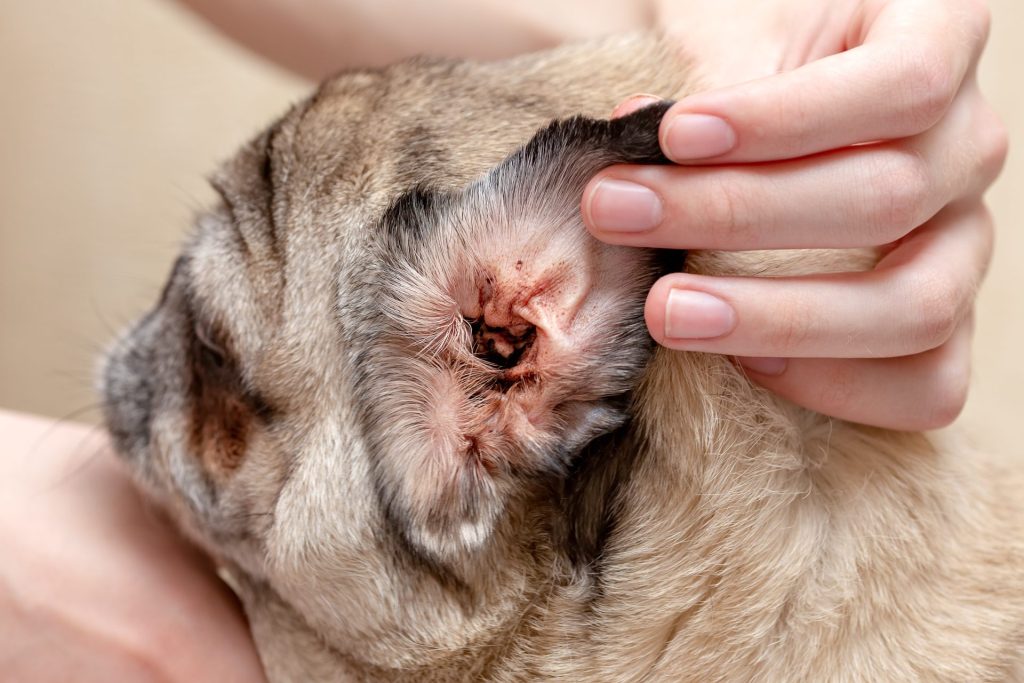
This dog mite picture shows small ear mites inside the Pug’s ear canal. This is where the Otodectes Cynotis mite likes to nest.
Under a microscope
- The Demodex Mite ( “Demodex Canis” ) – Under a microscope
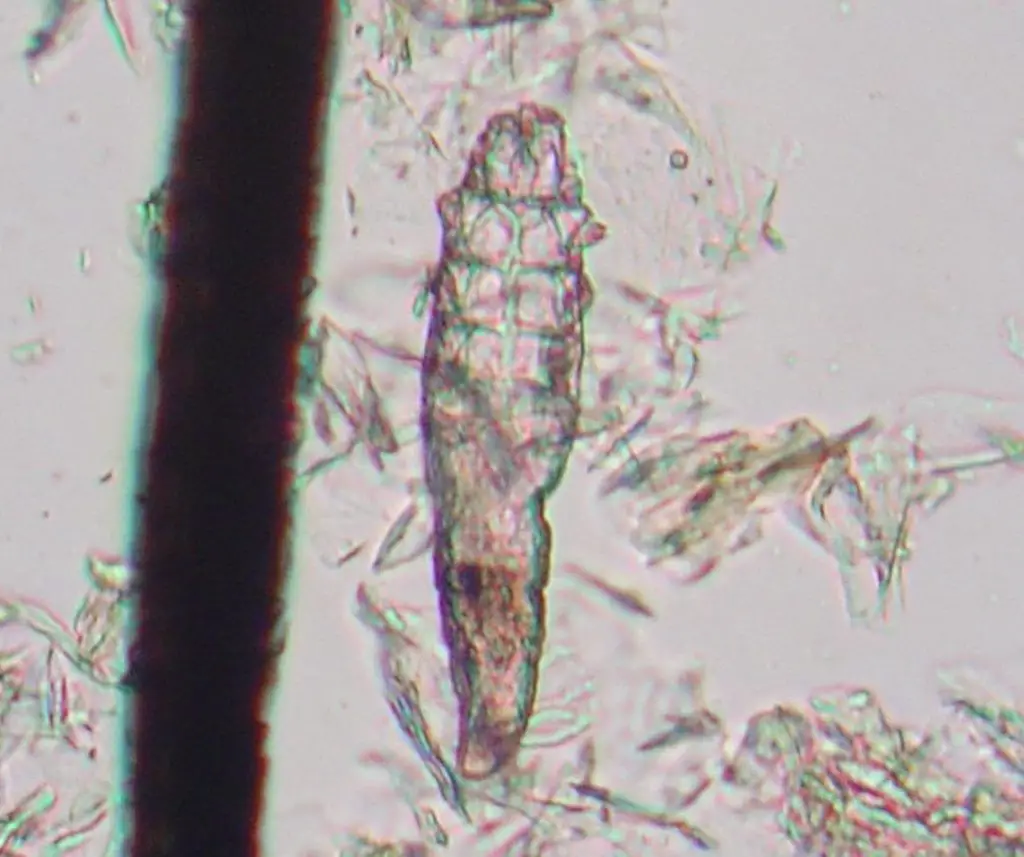
2. The Sarcoptic Scabei – Under a microscope
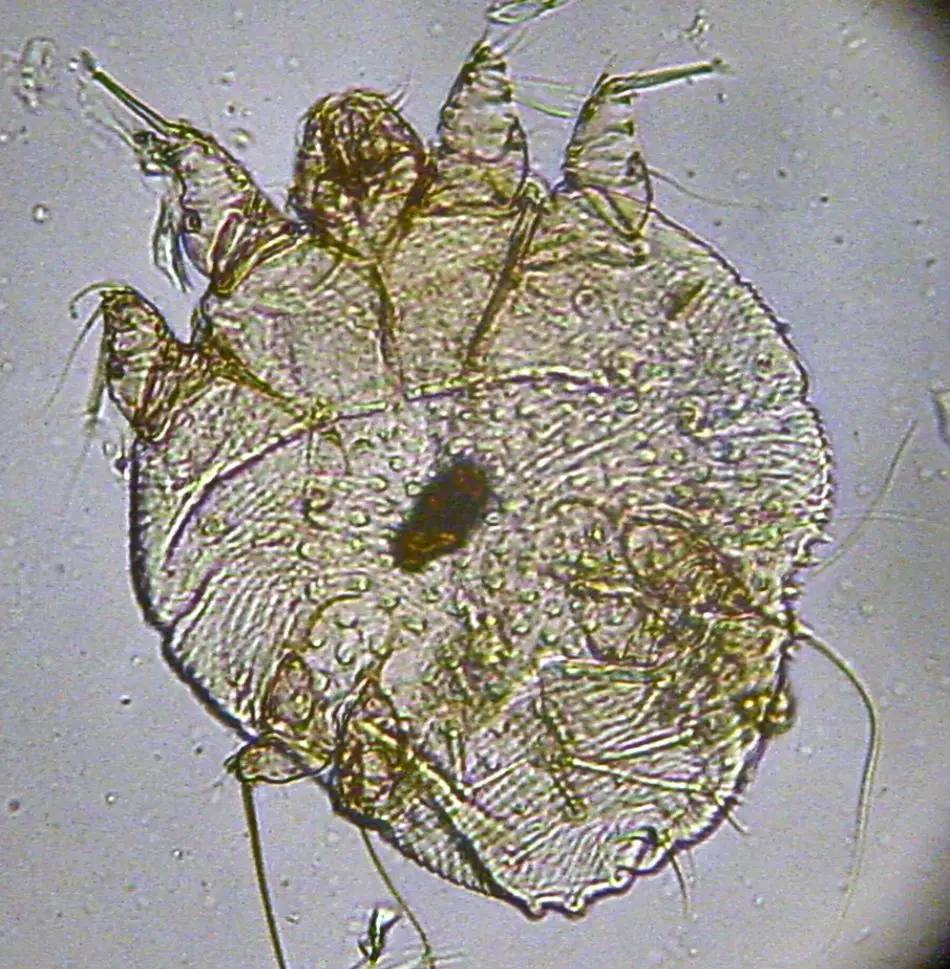
3. The Otodectes Cynotis – Under a microscope
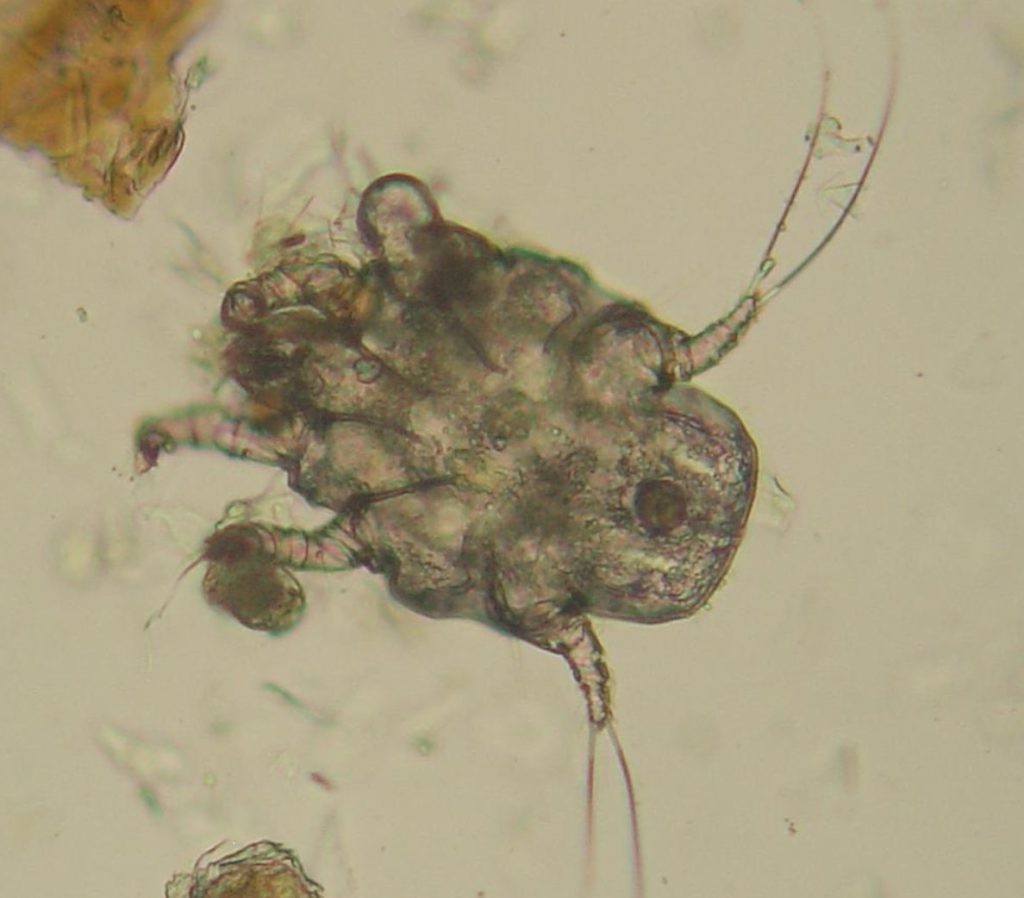
If you want to see how the impact of Mites on a dogs skin, then this is a great treatment video from Nat Geo.
Dog Mite Symptoms
If your dog has Mites, you will notices some of the following symptoms:
- Hair Loss (in patches or all over the coat)
- Flaky skin or Dandruff
- Aggressive and excessive scratching
- Red skin and sores or lesions
- Behavioural issues such as restlessness, not sleeping, whining
- Secondary infections (either fungal or bacterial which may indicate a compromised immune system)
How do you get rid of mites on a dog?
You can get rid of mites on dogs with a simple anti-parasitic wash. This is great news for dogs as it means these irritable infestations don’t need to last long at all! However, depending on the severity of the issue, good patience may be key. It might be the case that your furry friend needs a combination of topical treatments, for a longer period of time. But fear not, they’ll soon be back to their old selves.
Many mite shampoos can be found in your local pharmacy or supermarket, whereas others may only be available directly from the vets or online.
If you’re unsure on which shampoo to use, then please ask your vet as this is something that they’ll be more than qualified to recommend as different mites will require different treatments.
Some treatments might come in the form of topical creams, whereas others may be shampoos or tablets and sometimes antibiotics to help treat any secondary infections. Typical drugs that you may see recommended for the treatment of mange are:
- Amitraz
- Imidocloprid
- Slamectin
- Sarolaner
- Flurolaner
- Alfoxolaner
Here’s a good 7 step process to follow when treating dog mites:
1
Get an Expert diagnosis first
There are other conditions that may mimic mites, such as fleas or other allergy based illnesses.
2
Get a lab test
This includes a skin scrape and possibly a blood test. Getting this should show you which specific mite is the cause of the issue.
3
Consider prescription products
Products such as Nexgard Spectra kill mites effectively.
4
Medicated Wash
Depending on the severity, some dogs may require a medicated wash at the vets.
5
Treat other pets
Ensure other pets around the house are free of mites. Alert your neighbours to the issue too.
6
Hot washing
Clean bedding, carpets, clothes and toys with a hot wash. Be sure to clean and hoover as frequently as possible whilst trying to eliminate mites.
7
Home remedies
As a preventative measure, consider adding anti-mite home remedies as part of your bathing and grooming regimen.
Natural home remedies are well liked by some dog owners, but consistent evidence of effectiveness is often anecdotal (as you would expect). However, due to their low cost and low risk of side effects, it’s worth looking at the most popular at-home remedies for treating mites.
Natural Home Remedies for treating mites
Thankfully, there are a few home remedy treatments for dog mites. These range from spot cleaning to bathing. We must stress that if this is a root you choose to go down, then you should set yourself a timeframe for effectiveness. If you do not see results in that timeframe then please see your vet urgently.
Apple Cider Vinegar
Using apple cider vinegar for dog mites has a lot of anecdotal evidence, but nothing empirical. Dilute half a cup of apple cider vinegar in a large bowl of water and use a cloth to dab mange infected patches on your dogs skin.
It may be that the apple cider vinegar has some healing properties for bacterial infections and that it can relieve skin inflammation by helping to balance PH levels.
Honey
Honey has been used in natural medicine for thousands of years. It’s a natural antiseptic and can help cleanse the skin of bacteria, dirt and grime caused by mange. You can apply dollops of this to your dogs mange patches, but you will need to find a way to stop your dog from immediately licking it off.
Olive Oil
Much like honey, olive oil can help soothe the skin and therefore heal any sore spots caused by mange. However, it’s unlikely to kill mange by itself and should be used in conjunction with another, more potent home remedy mite treatment.
Natural Yoghurt
Full fat, low sugar natural yoghurts have been used in some home remedy mite treatments with varying results, again “anecdotal”.
The yoghurt is full of probiotics which if ingested aren’t exactly going to cause your dog harm. Owners slather the yoghurt on the affected areas which likely results in smothering the mites and slowly killing them.
Additionally, the yoghurt can help soothe the skin and ease the pain of any skin inflammation, with the probiotics potentially curing any fungi living on the dogs skin.
Yoghurt treatment could be a great option for localised infections, particularly around the feet or back.
As mentioned above, responsible ownership means that if you are to go down the path of natural remedies, then you need to give your dog a reasonable timeframe for which to see results.
If natural remedies don’t appear to help solve the issue, then please get in touch with your vet immediately as prolonged mange is only going to cause more long term damage.
Treatment for ear mites Specifically
We will do a follow-up article on the full diagnosis and treatment for ear mites, however from a very brief outline, treatment of ear mites will involve the following:
One or two treatments of spot on flea treatments can help treat and prevent ear mites. These are a lot less stressful for your dog than ear drops.
Many ear mite treatments need to go on for a prolonged period of time. This is because not many can effectively kill the eggs of the parasites which can take around 21 days to hatch. Therefore, the treatment needs to take place over 3-4 weeks to become fully effective.
There are more potent medications on the market that can get the job done in 10-14 days, however administering these stronger treatments will need to come as a direct recommendation from your vet and will likely depend on the severity of the ear mites problem.
If you are able diagnose ear mites effectively, then you must act quickly as ear mites can commonly spread to other house-hold of neighbourhood pets such as cats. If treatment is late, then ear mites can have a devastating impact on many other animals.
How to prevent dog mites In The Future
The most obvious answer to this is to prevent your dog from coming into contact with other dogs that have them. However, that’s a huge kop out as these things are never fully in your control.
That said, if your dog has had the unfortunate experience of having to deal with mites, then it is on you as a responsible owner to do what you can to prevent the issue from occurring again (at least to the best of your ability).
This means simple steps such as:
- Frequent washing of bedding and clothes
- Hoovering and mopping floors
- Keeping your dog away from strays and foxes
- Having a good, honest relationship with neighbours and dog walkers
- Consider adding some home remedy solutions to your grooming and bathing routine